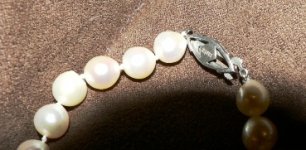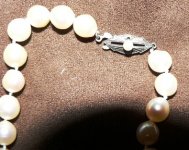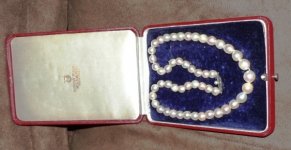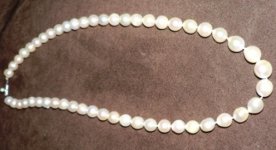When we married, my husband gave me his grandmother's Mikimoto pearls purchased in Kyoto, Japan in 1949. The strand is 19 inches long. They have been restrung and knotted. The clasp is sterling silver. It has a pearls in the middle -- no Mikimoto mark. The box is red and says K., Mikimoto, inc. It also says Ginza Tokyo. I'm not sure of the size of the pearls. The middle one is large and then they get smaller.
Today we went to Antiques Roadshow and the appraiser told me that they were worth less than $100. He said that they are not perfectly round and that they have some imperfections. My mother in law was shocked. She says that her father paid $300 for them in 1949. (It's possible that she has this information wrong.
Now I wonder if they are Mikimoto at all? Maybe my husbands grandfather got ripped off. Any insight from anyone?
Today we went to Antiques Roadshow and the appraiser told me that they were worth less than $100. He said that they are not perfectly round and that they have some imperfections. My mother in law was shocked. She says that her father paid $300 for them in 1949. (It's possible that she has this information wrong.
Now I wonder if they are Mikimoto at all? Maybe my husbands grandfather got ripped off. Any insight from anyone?




